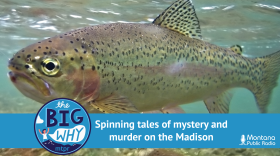-
Wind uprooted trees and downed powerlines this week in southcentral Montana.
-
New legislation from members of Montana's congressional delegation aims to make environmental restoration projects easier and less expensive.
-
While western Montana deals with drought and fire, southcentral and southeastern Montana are seeing elevated storm activity and increased risk of flash flooding.
-
A recent bird count shows more endangered whooping cranes are making the trip through the Great Plains than ever before.
-
Wildlife managers are asking Montanans to help spot a lizard that blends into the dry brush and grasslands of central and eastern Montana.
-
New laws signed by Gov. Greg Gianforte set aside tens of millions in marijuana revenue for conservation and wildlife habitat improvements, including the construction of wildlife crossings over busy roads.
-
A high-powered satellite photo reveals reddish mineral deposits in the region shared between Montana and Wyoming
-
Montana wildlife managers are looking for public feedback on their approach to balancing mule deer populations.
-
US Forest Service workers feel caught in limbo, as federal court orders move them back and forth between hired and fired. Some employees and business owners are certain about what they need to do.
-
In the '90s, whirling disease hit trout populations hard in Montana, at one point leading to a 95% decline in rainbow trout in the Madison River. It sparked concern among biologists, anger in tourist towns and even played a role in a murder mystery novel. It also inspired this week's question: What's happening with whirling disease and other threats to trout?
-
A Florida artist's swan-themed submission took home the prize in Montana's 2025 Migratory Bird Stamp competition.
-
Trapping season for furbearing animals is well underway and Montana Fish Wildlife & Parks is asking bobcat hunters and trappers this winter to submit samples of their catches.
















